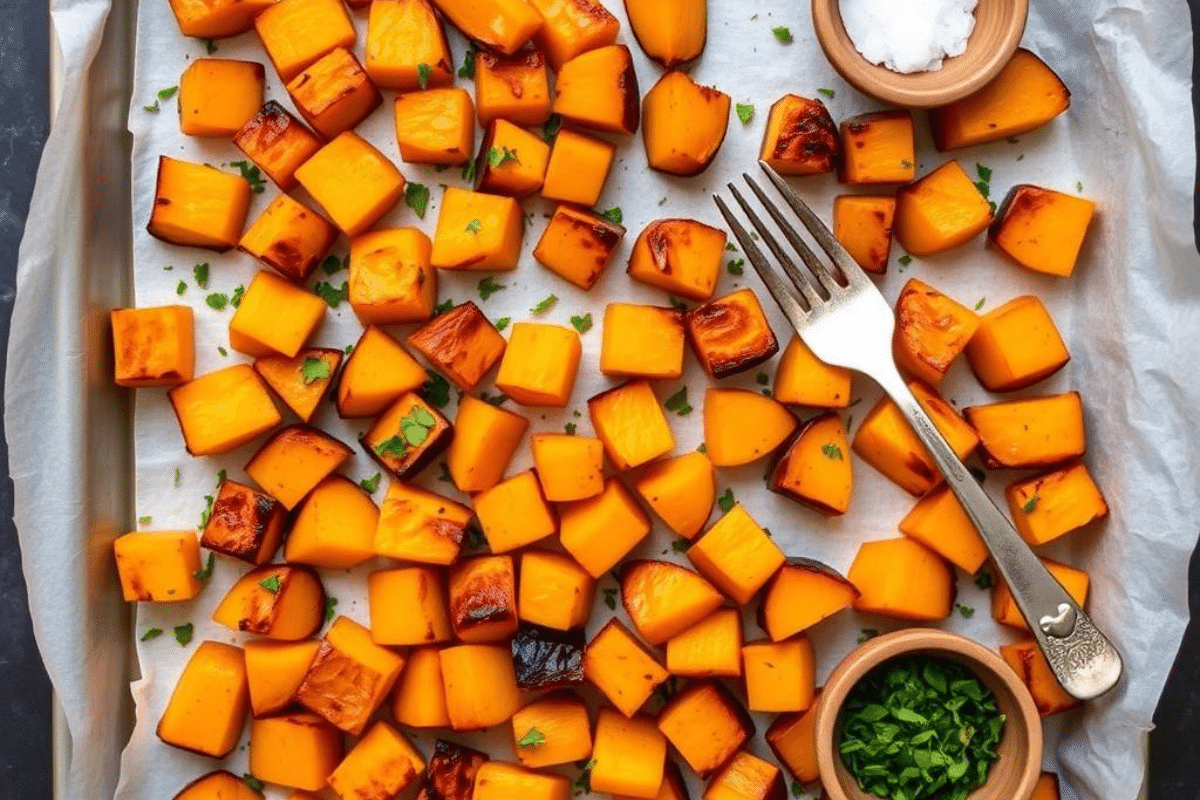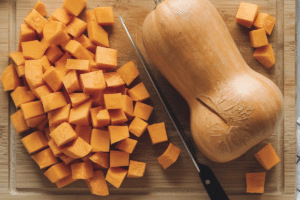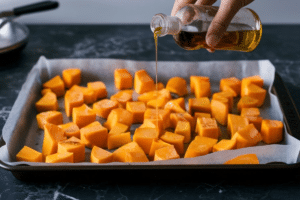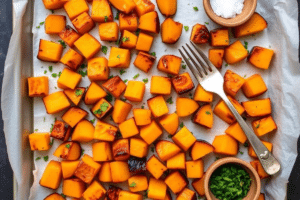Table of Contents
Introduction
Few foods can rival the culinary magic of roasted butternut squash. With its golden, soft flesh and subtly sweet flavor, this squash is a kitchen chameleon, ready to shine in soups, salads, or as a stand-alone side dish. Rich in vitamins, antioxidants, and fiber, it’s not just delicious—it’s a nutritional powerhouse that makes you feel good about every bite. But here’s the kicker: roasting transforms this humble vegetable into a caramelized, mouthwatering delight that you’ll want to eat straight from the pan. Stick around because we’re spilling the secrets to crafting the perfect recipe from picking the best squash to nailing that crispy, golden finish. Trust us, you won’t want to miss this.
Everything You Need to Know About Roasted Butternut Squash
Why Butternut Squash is a Must-Have Ingredient
- Butternut squash is a must-have ingredient because of its exceptional versatility, rich flavor, and impressive nutritional profile. Its natural sweetness enhances both savory dishes and desserts, while its abundance of vitamins, fiber, and antioxidants supports overall health. From soups to side dishes, it’s a powerhouse vegetable that elevates any meal.
How to Peel Butternut Squash
- Peeling a butternut squash is simple with the right approach. First, cut off both ends to create a stable base. Use a sturdy vegetable peeler or a sharp knife to remove the skin, working in downward strokes. Hold the squash firmly to prevent slipping, and always peel away from your body for safety. For tough spots, use the knife cautiously. With these steps, you’ll have a perfectly peeled squash ready to transform into culinary magic!
How to Cut Butternut Squash
- Cutting butternut squash begins with halving it lengthwise using a sharp knife; start at the top and work your way down. Scoop out the seeds with a spoon, then cut each half into manageable sections. For cubes, slice the squash into even pieces—about 1-inch cubes for uniform cooking. This size ensures the squash roasts evenly, with caramelized edges and tender centers. Always use a stable cutting board and firm grip for precision and safety while handling.
How to Roast Butternut Squash
Roasting Halved Butternut Squash
- To roast butternut squash halves, start by halving the squash lengthwise and scooping out the seeds. Brush the cut sides with olive oil, season as desired, and place them face-down on a baking sheet. Roast at 400°F for 40–50 minutes until tender. This method locks in moisture and enhances flavor. While roasting whole halves is easy and yields soft flesh, it takes longer and limits caramelization compared to cubed squash. Choose based on your dish!
Roasting Cubed Butternut Squash
- To roast cubed butternut squash, toss 1-inch cubes with olive oil, salt, and spices. Spread them evenly on a baking sheet, ensuring they don’t overlap for proper browning. Roast at 400°F for 25–30 minutes, flipping halfway through. For caramelized edges and tender centers, avoid overcrowding and let the natural sugars work their magic in the heat.
Common Mistakes to Avoid
Avoid overcrowding the baking sheet, as this traps steam and prevents the squash from roasting evenly and developing caramelized edges. Always preheat your oven for consistent cooking and enhanced flavor. Skipping proper seasoning can result in bland squash—ensure every cube is coated with oil and spices for a perfectly roasted, flavorful dish every time.
Ways to Serve Roasted Butternut Squash
- Roasted butternut squash is a versatile addition to any meal. Serve it as a festive holiday side dish or incorporate it into hearty soups, fresh salads, or comforting casseroles. Its natural sweetness and caramelized flavor pair beautifully with grains, greens, or creamy sauces, making it a standout ingredient in countless creative recipes.
What to Do with Leftovers
Leftover roasted butternut squash can be stored in an airtight container in the fridge for up to 4 days or frozen for up to 3 months. Repurpose it creatively by blending it into creamy soups, spreading it on toast, or adding it to tacos for a unique twist. It also makes a delightful addition to breakfast bowls or purees for sauces and dips. The possibilities are ENDLESS
Roasted Butternut Squash Nutrition Facts
Roasted butternut squash is a nutrient-dense delight, with just 82 calories, 22 grams of carbs, and less than 1 gram of fat per serving (1 cup). Rich in vitamin A, vitamin C, potassium, and fiber, it supports eye health, immunity, and digestion. Its natural sweetness and low-calorie profile make it a fantastic addition to a balanced diet, offering both flavor and nourishment.
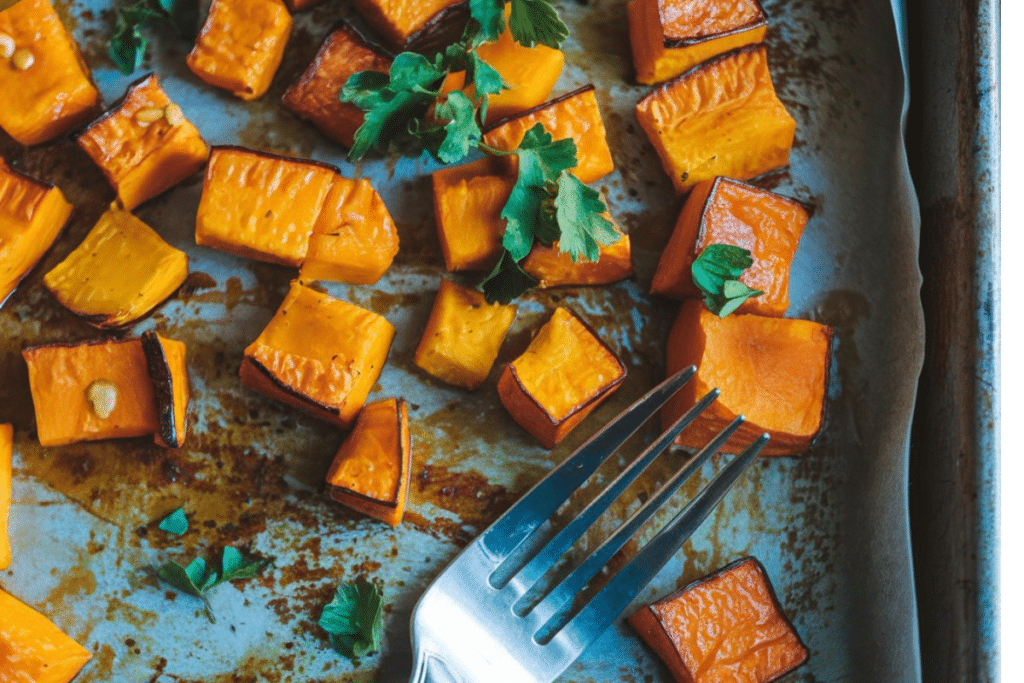
Why You’ll Fall in Love with Butternut Squash recipe
Roasted butternut squash is a culinary treasure, combining incredible versatility, effortless preparation, and robust nutritional value. Its sweet, nutty flavor pairs beautifully with countless seasonings and dishes, making it a favorite for all occasions. Let your creativity shine by experimenting with unique spice blends or transforming it into soups, salads, or hearty sides. You’ll love its endless possibilities!
FAQ’S
Why is my roasted butternut squash mushy?
Mushy roasted butternut squash occurs when the baking sheet is overcrowded, trapping moisture and preventing caramelization. Using a low oven temperature can also lead to steaming instead of roasting. To achieve perfectly crisp edges, spread the squash in a single layer and roast at 400°F, ensuring even heat and proper airflow.
What is the liquid coming out of my butternut squash?
The liquid from your butternut squash is its natural moisture, released during cooking. This water contains sugars that can caramelize at higher temperatures, enhancing flavor. If too much liquid pools, it may indicate overcrowding on the baking sheet. Ensure proper spacing to allow the squash to roast effectively.
Should I roast butternut squash face down or up?
Roasting butternut squash face down is ideal for tender, evenly cooked flesh with caramelized edges. The cut side traps heat and moisture, speeding up cooking. If you prefer a slightly crisp texture or wish to add seasonings on top, roast it face up, but expect longer cooking times for similar results.
Should you wash butternut squash before cooking?
Yes, you should wash butternut squash before cooking to remove any dirt, bacteria, or pesticide residues on the skin. Use cool running water and a vegetable brush to scrub the surface gently. Even if you plan to peel the squash, washing ensures cleanliness. It prevents contaminants from transferring to the flesh during preparation.
Why does my butternut squash taste weird?
Butternut squash may taste weird if it is overripe, underripe, or improperly stored. A bitter or off flavor can indicate spoilage or exposure to extreme temperatures. Ensure the squash is fresh, with firm skin and no soft spots. Proper seasoning and roasting can also enhance its natural sweetness and flavor.
Is it better to roast or steam butternut squash?
Roasting and steaming butternut squash serve different purposes. Roasting enhances its natural sweetness and creates caramelized edges with a rich, nutty flavor. On the other hand, steaming yields a softer texture, ideal for purees or soups. Roasting is often the better choice for vibrant, flavorful dishes, adding depth and a delightful texture. vibrant, flavorful dishes, roasting is often the better choice, adding depth and a delightful texture.
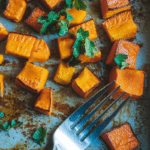
4 Ingredients For Best Roasted butternut squash
- Total Time: 40 minuted
- Yield: 4 serving 1x
Description
Mastering the art of roasting butternut squash is simple and effortless, making it a tasty side dish or a flavorful addition to all your favorite fall recipes.
Ingredients
-
- 1 medium butternut squash, peeled and cubed
-
- 2 tablespoons olive oil
-
- 1 teaspoon salt
-
- ½ teaspoon black pepper
Optional Add-Ons for Flavor Variations:
-
- 1 teaspoon cinnamon and ¼ teaspoon nutmeg (sweet option)
-
- 1 teaspoon smoked paprika or chili powder (savory option)
-
- 2 teaspoons maple syrup or honey
-
- 1 tablespoon fresh rosemary or thyme, chopped
-
- 1 teaspoon garlic powder or onion powder
Instructions
-
- Preheat the Oven
-
- Set your oven to 400°F (200°C) and line a baking sheet with parchment paper for easy cleanup.
-
- Prepare the Squash
-
- Peel the butternut squash, remove the seeds, and cut it into evenly sized 1-inch cubes.
-
- Season the Squash
-
- Place the cubes in a large bowl. Drizzle with olive oil, then sprinkle with salt, pepper, and other seasonings. Toss well to ensure even coating.
-
- Spread on Baking Sheet
-
- Arrange the seasoned cubes in a single layer on the prepared baking sheet, leaving space between pieces to promote caramelization.
-
- Roast the Squash
-
- Roast in the preheated oven for 25–30 minutes, flipping halfway through to achieve even browning.
-
- Check for Doneness
-
- The squash is ready when the edges are golden and caramelized, and the centers are fork-tender.
-
- Serve and Enjoy
-
- Transfer to a serving dish and enjoy warm as a side or incorporate into your favorite recipes.
Notes
For perfectly roasted squash, cut pieces evenly to ensure uniform cooking. Add a sprinkle of brown sugar or drizzle of balsamic vinegar for extra caramelization. If the squash isn’t browning, increase the oven temperature slightly or use the broiler briefly. Avoid overcrowding the baking sheet to maintain crispy edges.
- Prep Time: 10 minutes
- Cook Time: 30 minutes
- Category: side-Dish
- Method: Roasting
- Cuisine: American
Nutrition
- Serving Size: 1 cup roasted squash
- Calories: 120g
- Sugar: 4g
- Sodium: 150g
- Fat: 5g
- Saturated Fat: 1g
- Unsaturated Fat: 4g
- Trans Fat: 0g
- Carbohydrates: 18g
- Fiber: 4g
- Protein: 2g
- Cholesterol: 0g
Keywords: roasted butternut squash, butternut squash recipe, easy side dish

